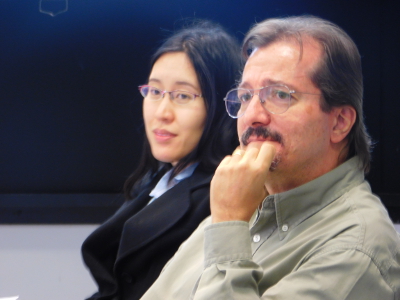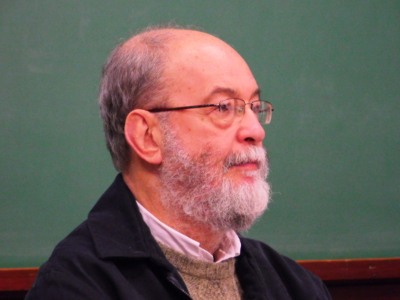
Integrating research, technology transfer and dissemination: NeuroMat’s third report of activities
Oct 26, 2016
When the São Paulo Research Foundation established the structure of the Research, Innovation and Dissemination Centers it stated clearly that the most important feature of RIDCs was the multiplicity of their missions, a cornerstone for attaining the status of “a world class research center.” Each RIDC must have a specific, high-impact research focus, and this research focus must be necessarily integrated with technology-transfer and scientific dissemination explicit missions. FAPESP's RIDC for Neuromathematics (NeuroMat), that was established in 2013 and is coordinated by mathematician Antonio Galves, reports its third year of activities by emphasizing how the major scientific challenge of building a conceptual framework for neuroscience data informs technology transfer and scientific dissemination.
NeuroMat’s research outputs in the third report of activities indicate a scientific crescendo in the development of a new stochastic model for biological neural networks and of the stochastic modeling of the statistician brain conjecture. Since the second report of activities, last year, 29 papers were either published or accepted for publication. Citations according to Google Scholar went up from 61 in 2014 to 113 in 2015 and 141 as of October 2016. This growing impact was embedded in a context of dense research exchange, including three major conferences in the reported year of activities: the workshop Random Graphs in the Brain (Nov. 2015), the VI Edition of the Latin American School on Computational Neuroscience (Jan. 2016) and the workshop High-Performance Computing, Stochastic Modeling and Databases in Neuroscience (Apr. 2016). How well was NeuroMat’s scientific crescendo integrated to technology-transfer and dissemination activities?
Technology transfer
NeuroMat’s technology-transfer activities have occurred in two fronts, according to the third report of activities: Neuro-rehabilitation and diagnosis, and Computational tools. The former is split in three main initiatives: Plasticity in brachial plexus avulsion (BPA), Psychosis and psychiatric illnesses and Plasticity in Parkinson’s disease (PD), respectively coordinated by Claudia D. Vargas, Sidarta Ribeiro and Maria Elisa Piemonte. Computational tools included in the report: the Neuroscience Experiments System (NES), the Goalkeeper Game and the NeuroMat Open Database for neuroscientific data.
 |
The work on BPA and PD are intimately related to the research agenda of the team led by Vargas, Antonio Galves, according to NeuroMat technology-transfer coordinator, Antonio Carlos Roque da Silva. “The major scientific challenge is to develop a brain plasticity conceptual framework based on their work on learning context trees, and the major technology-transfer challenge is to develop new therapeutic protocols specific for BPA and PD based on this framework.” The line of activity on psychosis and psychiatric illnesses is conducted by a NeuroMat team led by Sidarta Ribeiro, who proposes a graph-theoretic representation and analysis of speech structures of patients with illnesses like schizophrenia, bipolar mood disorder and Alzheimer's disease.
“The short-term outcomes for these three areas are to develop successful therapeutic protocols and evaluation instruments relying on results already available from our basic science studies on each respective area. The long-term outcomes would be to perfect these protocols and develop new ones incorporating new knowledge from our ongoing research. It is important to mention that the activities associated to BPA and PD will be done in the context of the newly created support networks AMPARO (Rede de apoio NeuroMat a amigos e pessoas com doença de Parkinson) and ABRAÇO (Iniciativa NeuroMat para estudo e reabilitação das lesões do plexo braquial),” said Roque da Silva. AMPARO was launched in October, with a presentation video and a reference website; ABRAÇO is being developed.
The RIDC has reached a new stage in the work around technology transfer, according to the coordinator of the area. “During this first half of its existence, NeuroMat has been more concerned with the development of new research results in basic science than with technology transfer, and the reason is simple to explain. NeuroMat's main mission is not to apply existing mathematics-based technology tools to neuroscience-related areas but to create new tools, and then develop applications based on them to be transferred as innovative technology. So, I would not expect that NeuroMat had an intense technology transfer activity during its first three years of existence.” Now, said Roque, the challenge is to turn NeuroMat’s novel basic research into products and techniques that can be applied to neuroscience and neurology. According to Roque da Silva, current post-injury treatment practice is largely based on empirical evidence with little input from basic knowledge on synaptic plasticity phenomena. The work of Duarte, Fraiman, Galves, Ost and Vargas, “Retrieving a hidden context tree from EEG data”, has opened the possibility of studying how the brain learns context trees underlying complex sequences of events, said NeuroMat’s technology-transfer coordinator. “This is a first step in the construction of a conceptual framework for brain plasticity, which would bridge from plasticity at the synaptic level to plasticity at the systemic level. While we are still working on the development of this framework (a basic science achievement), we have already started to develop therapeutic protocols based on the findings of that work (a technology-transfer achievement).”
The development of computational tools within NeuroMat has been associated, from Roque da Silva’s perspective, to a real explosion of data in neuroscience that has created a significant demand for efficient storage and retrieval of data. The tool Neuroscience Experiments System (NES) remains a free and open-source software for storing and retrieving different types of neuroscience data (clinical, electrophysiological, imaging, behavioral, etc) in a way that allows verification and reproduction of experimental results. “These are complex tasks and NeuroMat has a special team of computer experts and analysts working on NES development. Associated to it is the construction of the NeuroMat database, which will initially contain data from our work on BPA, PD and psychosis and psychiatric illnesses. This database will be made public so patient and other sensitive data will be anonymized. Both for basic and clinical research in neuroscience, it is important to have a representative database and a database management system with a rich repertoire of user-friendly facilities, and to achieve this is the main challenge for our team working on this project.”
According to the NeuroMat technology-transfer coordinator, the goalkeeper game is a direct development of the basic research on retrieving and learning context trees. “The original protocol used by Duarte et al. to study whether or not the brain learns context trees may be a bit boring for subjects participating in the experiments, and so we developed a new protocol based on a penalty shootout videogame, which has been shown in preliminary studies to keep the attention of participant subjects for periods of time long enough to allow statistical analysis. The challenge of this project is to develop an entertaining and yet scientifically useful videogame that allows gathering of good amounts of data for our studies.”
Dissemination
 |
As Antonio Carlos Roque da Silva became head of NeuroMat’s technology-transfer team, physicist Fernando da Paixão, from the State University of Campinas, stepped in as the NeuroMat scientific dissemination coordinator. “One important request by FAPESP is to communicate our research. This includes the research community but also a general audience. This has been done in several ways. The Neuromat website has been designed to provide information about all activities like: paper published, lectures delivered, meetings. We have a blog Traço da Ciência and several activities related with improving the Portuguese version of Wikipedia, which can be used by a general public. Now we are working in a statistical course that will relate basic concepts with the research done at NeuroMat.” The general goal of these activities is to close the gap between the frontier of science, especially what is produced by the NeuroMat research team, and wider audiences.
A challenge in the process of disseminating science in Brazil is the general context of scientific illiteracy. According to the PISA assessment, organized by the OECD to evaluate scientific literacy, Brazil remains at a low level of mathematic literacy, defined as: “an individual’s capacity to formulate, employ, and interpret mathematics in a variety of contexts . . . [including] reasoning mathematically and using mathematical concepts, procedures, facts and tools to describe, explain and predict phenomena.” Brazil’s profile on the PISA assessment states: “Brazil performed well below the OECD average in mathematics on PISA 2012 (391 mean score points, compared to the OECD average of 494 score points);” based on the same document, “Brazil made the greatest improvement in mathematics performance between 2003 and 2012 (an increase of 35 score points, compared to a decrease of 3 score points among OECD countries). Brazil had one of the largest decreases in the proportion of low performers (15-year-old students performing below the baseline proficiency Level 2). However, 67.1% of 15-year-old students in Brazil still do not meet basic proficiency in mathematics, compared to 23% among OECD countries.”
The largest ongoing strategy by NeuroMat to tackle scientific illiteracy has been the Wikipedia Initiative, according to Paixão. In a collaboration among scientists, journalists, students and volunteer Wikipedians, hundreds of entries pertaining to mathematics and neurobiology were improved on the Portuguese version of Wikipedia, one of the largest go-to reference in Portuguese. In 2016, one million bytes of information had been added on the electronic encyclopedia (as of October 2016), with views to texts and images raising to 5 million. Paixão intends to connect this initiative to a course on statistics with teachers from public schools he is currently devising.
Paixão has emphasized that activities around AMPARO have been a confluence point of interest and activities of the three NeuroMat broad areas. According to him, this synergy on a practical outcome could become a new means of integrating research, technology transfer and dissemination.
This piece is part of NeuroMat's Newsletter #33. Read more here
Share on Twitter Share on Facebook| NeuroCineMat |
|---|
|
Featuring this week: |
| Newsletter |
|---|
|
Stay informed on our latest news! |
| Follow Us on Facebook |
|---|




